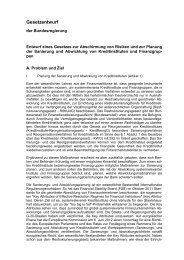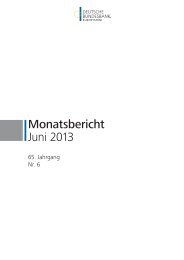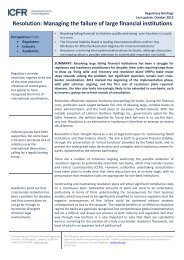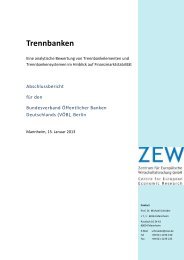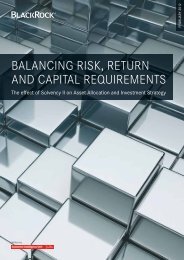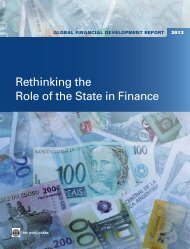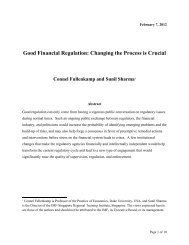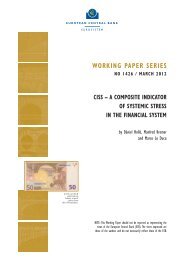ESRB RISK DASHBOARD - European Systemic Risk Board - Europa
ESRB RISK DASHBOARD - European Systemic Risk Board - Europa
ESRB RISK DASHBOARD - European Systemic Risk Board - Europa
You also want an ePaper? Increase the reach of your titles
YUMPU automatically turns print PDFs into web optimized ePapers that Google loves.
<strong>ESRB</strong> <strong>RISK</strong> <strong>DASHBOARD</strong><br />
Cut-off date: 1 March 2013<br />
DISCLAIMER: The risk dashboard is a set of quantitative indicators and not an early-warning system.<br />
Users may not rely on the indicators as a basis for any mechanical form of inference.
Table of contents<br />
1. Interlinkages and composite measures of systemic risk 5<br />
1.1 Composite indicator of systemic stress (CISS) 5<br />
1.2 Probability of a simultaneous default by two or more large and complex banking groups 5<br />
1.3 Average contribution of individual institutions to overall systemic risk using CoVaR (EU financial system) 6<br />
1.4 Co-movements of sovereign credit default swap (CDS) spreads 6<br />
1.5 Cross-border claims of banks (international banking statistics) 7<br />
2. Macro risk 8<br />
2.1 Current and forecast real GDP growth 8<br />
2.2 Domestic credit-to-GDP gap 8<br />
2.3 Current account balance-to-GDP ratio 9<br />
2.4 Unemployment rate 9<br />
2.5 General government debt-to-GDP ratio 10<br />
2.6 General government deficit-to-GDP ratio 10<br />
2.7 Credit default swap premia on sovereign debt in selected EU countries 11<br />
2.8 Sovereign debt redemptions 11<br />
2.9 Households’ debt-to-gross disposable income ratio 12<br />
2.10 Economic sentiment indicator 12<br />
2.11 Global PMI output and industrial production 13<br />
2.12 Gold and Brent crude oil prices 13<br />
2.13 Non-financial corporations’ debt-to-GDP ratio 14<br />
3. Credit risk 15<br />
3.1 Residential property prices 15<br />
a) Estimates of the over/undervaluation of residential property prices in selected EU countries 15<br />
b) Change in nominal residential property prices 15<br />
3.2 Foreign currency loans in the EU 16<br />
a) Share in total loans and annual growth rates 16<br />
b) Foreign currency loans, broken down by domestic counterpart sector 16<br />
3.3 Yields on euro area non-financial corporate bonds, broken down by rating class 17<br />
3.4 Lending spreads of monetary financial institutions - loans to non-financial corporations and households 17<br />
3.5 Changes in credit standards for residential mortgage loans 18<br />
3.6 Changes in credit standards for loans to large enterprises 18<br />
4. Funding and liquidity 19<br />
4.1 Interbank interest rate spreads 19<br />
4.2 Financial market liquidity indicator for the euro area 19<br />
4.3 EUR/USD cross-currency basis swap spreads 19<br />
4.4 Loan-to-deposit ratio for a sample of large EU banking groups 19<br />
4.5 Pattern of credit institutions’ liabilities 20<br />
a) Liabilities of euro area credit institutions, broken down by instrument 20<br />
b) Liabilities of EU credit institutions by country - historical distribution of annual growth rates 20<br />
4.6 Share of central bank funding in credit institutions’ liabilities 21<br />
4.7 Money markets and the Eurosystem’s standing facilities 21<br />
4.8 Maturity profile of EU banks’ outstanding long-term debt 22<br />
5. Market risk 23<br />
5.1 Global risk aversion indicator 23<br />
5.2 Equity indices 24<br />
a) Equity indices, broken down by market 24<br />
b) Equity indices, broken down by sector 24<br />
c) Equity implied volatility indices: S&P 500 and Euro Stoxx 50 24<br />
5.3 Price/earnings ratio of equity indices, broken down by sector 25<br />
5.4 Short-term interest rates - implied volatility: three months - one year 25<br />
5.5 Long-term interest rates - implied volatility: three months - ten years 25<br />
5.6 Exchange rate volatility 25<br />
<strong>ESRB</strong> risk dashboard • 1 M a r c h 2 0 1 3<br />
3
Table of contents - continued<br />
6. Profitability and solvency 26<br />
6.1 Slope of the yield curve 26<br />
Sample of large EU banking groups 27<br />
6.2 Profitability indicators 27<br />
a) Return on equity 27<br />
b) Cost-to-income ratio 27<br />
c) Net interest income to total operating income 27<br />
6.3 Solvency indicators 28<br />
a) Tier 1 capital to total assets excluding intangible assets 28<br />
b) Impaired loans and past due (>90 days) loans to total loans 28<br />
Sample of large EU insurance groups 29<br />
6.4 Profitability indicators 29<br />
a) Return on equity 29<br />
b) Combined ratio - non-life insurance business 29<br />
c) Gross premiums written - life insurance business 29<br />
d) Gross premiums written - non-life insurance business 29<br />
6.5 Solvency indicators 30<br />
a) Solvency ratio - life insurance business 30<br />
b) Solvency ratio - non-life insurance business 30<br />
6.6 Retention ratio 30<br />
6.7 Samples of large EU banking groups and large EU insurance groups 31<br />
List of countries<br />
Austria AT France FR Poland PL<br />
Belgium BE Greece GR Portugal PT<br />
Bulgaria BG Hungary HU Romania RO<br />
Cyprus CY Ireland IE Sweden SE<br />
Chech Republic CZ Italy IT Slovenia SI<br />
Germany DE Lithuania LT Slovakia SK<br />
Denmark DK Luxembourg LU United Kingdom UK<br />
Estonia EE Latvia LV Japan JP<br />
Spain ES Malta MT United States US<br />
Finland FI The Netherlands NL<br />
List of acronyms<br />
BIS Bank for International Settlements EU <strong>European</strong> Union<br />
CDS credit default swap FINREP Financial Reporting<br />
CISS composite indicator of systemic stress IMF International Monetary Fund<br />
COREP common solvency ratio reporting IPD Investment Property Databank<br />
EA euro area MFI monetary and financial institutions<br />
EBA <strong>European</strong> Banking Authority OECD Organisation for Economic Co-operation and<br />
ECB <strong>European</strong> Central Bank Development<br />
EIOPA <strong>European</strong> Insurance and OIS overnight indexed swap<br />
Occupational Pensions Authority PMI purchasing managers index<br />
ESCB <strong>European</strong> System of Central Banks SRM systemic risk measure<br />
Cut-off date<br />
Data available to the ECB by Friday, 1 March 2013 were taken into account in these statistics.<br />
Contact<br />
For enquiries regarding the risk dashboard and its contents, please contact: statistics@ecb.europa.eu<br />
4 <strong>ESRB</strong> risk dashboard 1 M a r c h 2 0 1 3
1. Interlinkages and composite measures of systemic risk<br />
1.1 Composite indicator of systemic stress (CISS)<br />
(8 Jan. 1999 - 22 Feb. 2013)<br />
1.1<br />
0.9<br />
0.7<br />
0.5<br />
0.3<br />
0.1<br />
-0.1<br />
-0.3<br />
-0.5<br />
1999 2000 2001 2002 2003 2004 2005 2006 2007 2008 2009 2010 2011 2012<br />
<strong>ESRB</strong> risk dashboard 1 M a r c h 2 0 1 3<br />
money market<br />
financial sector<br />
bond market<br />
forex market<br />
equity market<br />
correlation<br />
Sources: Thomson Reuters, ECB and ECB calculations.<br />
Notes: The CISS includes 15 raw, mainly market-based financial stress measures that are split equally into five categories, namely the financial intermediaries sector,<br />
money markets, equity markets, bond markets and foreign exchange markets. The CISS thus places relatively more weight on situations in which stress prevails<br />
simultaneously in several market segments. It is unit-free and constrained to lie witin the interval (0, 1). For further details, see Hollo, D., Kremer, M. and Lo Duca, M.,<br />
‘‘CISS - a composite indicator of systemic stress in the financial system’’, Working Paper Series, No 1426, ECB, March 2012.<br />
1.2 Probability of a simultaneous default by two or more large and complex banking groups<br />
(as measured by the systemic risk measure (SRM))<br />
(3 Jan. 2007 - 27 Feb. 2013; percentages)<br />
30<br />
25<br />
20<br />
15<br />
10<br />
5<br />
0<br />
2007 2008 2009 2010 2011 2012<br />
Sources: Thomson Reuters and ECB calculations.<br />
Notes: An estimate of the probability of a systemic event, i.e. a simultaneous default by two or more large and complex banking groups within a period of one year,<br />
as measured by the systemic risk measure (SRM). The SRM covers a sample of 15 banks. For further details on the indicator, see Box 8 in, Financial Stability Review,<br />
ECB, June 2012.<br />
CISS<br />
1.1<br />
0.9<br />
0.7<br />
0.5<br />
0.3<br />
0.1<br />
-0.1<br />
-0.3<br />
-0.5<br />
30<br />
25<br />
20<br />
15<br />
10<br />
5<br />
0<br />
5
1.3 Average contribution of individual institutions to overall systemic risk using CoVaR (EU financial system)<br />
(5 Jan. 1999 - 28 Feb. 2013; (log) EUR price)<br />
0.00<br />
-0.01<br />
-0.02<br />
-0.03<br />
-0.04<br />
-0.05<br />
-0.06<br />
-0.07<br />
-0.08<br />
1999 2000 2001 2002 2003 2004 2005 2006 2007 2008 2009 2010 2011 2012<br />
Source: Bloomberg.<br />
Notes: The indicator is based on the methodology proposed by Adrian and Brunnermeier (see Adrian, T. and Brunnermeier, M.K., ‘‘CoVar’’, Federal Reserve Bank of New York<br />
Staff Reports, No 348, September 2011). The sample includes the (log) stock prices of 119 <strong>European</strong> financial institutions listed in the STOXX600 (52 banks,<br />
33 financial service providers and 34 insurance companies). The average ‘‘systemic risk contribution’’ (loss) tends to be higher during stress periods.<br />
1.4 Co-movements of sovereign credit default swap (CDS) spreads<br />
(1 Jun. 2006 - 28 Feb. 2013; score of the first principal component)<br />
8<br />
7<br />
6<br />
5<br />
4<br />
3<br />
2<br />
1<br />
0<br />
-1<br />
-2<br />
-3<br />
Europe sub-sample 1 sub-sample 2<br />
-4<br />
2006 2007 2008 2009 2010 2011 2012<br />
Source: Markit.<br />
Notes: The indicator for Europe is based on the spreads of 12 sovereign CDSs, namely those of Belgium, Germany, Ireland, Greece, Spain, France, Italy,<br />
the Netherlands, Austria, Portugal, Finland and the United Kingdom. The sub-sample 1 indicator is based on the CDS spreads of countries hit by the sovereign<br />
crisis (Ireland, Greece, Spain, Italy and Portugal), while the sub-sample 2 indicator is based on those of the remaining countries (Belgium, Germany, France,<br />
the Netherlands, Austria, Finland and the United Kingdom). All indicators are constructed from the first component extracted through principal component analysis (PCA).<br />
An increase in the indicator suggests an increase in the joint default risk. A specific level for Greece’s default probability is assumed for the period in which Greek CDSs<br />
were not traded, i.e. the period between 9 March (credit event) and 11 April 2012.<br />
6 <strong>ESRB</strong> risk dashboard 1 M a r c h 2 0 1 3<br />
0.00<br />
-0.01<br />
-0.02<br />
-0.03<br />
-0.04<br />
-0.05<br />
-0.06<br />
-0.07<br />
-0.08<br />
8<br />
7<br />
6<br />
5<br />
4<br />
3<br />
2<br />
1<br />
0<br />
-1<br />
-2<br />
-3<br />
-4
1.5 Cross-border claims of banks (international banking statistics)<br />
(Q3 2012 (foreign claims) and Jun. 2012 (total consolidated capital); percentages)<br />
lenders and borrowers, EU only other EU countries other non-EU countries<br />
US<br />
PT<br />
ES<br />
<strong>ESRB</strong> risk dashboard 1 M a r c h 2 0 1 3<br />
IE<br />
FR<br />
UK<br />
BE<br />
NL<br />
IT<br />
NO<br />
(75%, 100%] (100%, 200%] (200%, 300%] above 300%<br />
Sources: Bank for International Settlements (BIS), ECB and ECB calculations.<br />
Notes: The size of the bubbles corresponds to the share of total foreign claims (BIS data) in the total equity (ECB data) of a country’s consolidated banking sector. The thickness<br />
of the arrows depends on the share of bilateral foreign claims (i.e. claims of banks in country A on banks and other borrowers in country B) in the total equity of the banking<br />
sector extending the loans. Arrows extend only from EU countries reporting consolidated banking statistics to the BIS (marked as lenders and borrowers, EU only) and only<br />
where the share of bilateral foreign claims in total equity is more than 75%. Data for foreign claims refer to claims on an immediate borrower basis; for more details, see<br />
Guidelines to the international consolidated banking statistics, available at http://www.bis.org. BIS statistics for Q3 2012 are still preliminary and subject to change.<br />
DK<br />
DE<br />
AT<br />
CZ<br />
SE<br />
GR<br />
RO<br />
BG<br />
FI<br />
CY<br />
TR<br />
7
2. Macro risk<br />
2.1 Current and forecast real GDP growth<br />
(Q1 2010 - Q4 2012; percentages; year-on-year growth)<br />
6<br />
4<br />
2<br />
0<br />
-2<br />
-4<br />
-6<br />
-8<br />
- - - -<br />
three-year historical average last observation - 2013 forecast<br />
-<br />
-<br />
- - -<br />
-<br />
-<br />
- -<br />
-<br />
EU EA AT BE BG CY CZ DE DK EE ES FI FR GR HU IE IT LT LU LV MT NL PL PT RO SE SI SK UK<br />
Sources: <strong>European</strong> Commission and the <strong>European</strong> Commission winter 2013 forecast.<br />
Notes: The three-year historical average is the average of the year-on-year growth rates over the last 12 quarters. For BE, BG, CZ, DK, EE, IE, ES, CY, LV, LU, HU, MT,<br />
PL, PT, SI, FI and SE, "last observation" refers to Q3 2012.<br />
2.2 Domestic credit-to-GDP gap<br />
(Q4 2010 - Q3 2012; percentages)<br />
5<br />
0<br />
-5<br />
-10<br />
-15<br />
-20<br />
-25<br />
8 <strong>ESRB</strong> risk dashboard 1 M a r c h 2 0 1 3<br />
-<br />
Q4 2010 Q4 2011 last observation<br />
EA AT BE BG CY CZ DE DK EE ES FI FR GR HU IE IT LT LU LV MT NL PL PT RO SE SI SK UK<br />
Sources: <strong>European</strong> Commission, ECB and ECB calculations.<br />
Notes: The domestic credit-to-GDP gap is calculated as the difference between the ratio of notional stocks of domestic credit to nominal GDP and its recursive Hodrick-Prescott<br />
trend (see Alessi, L. and Detken, C., ‘‘Quasi real time early warning indicators for costly asset price boom/bust cycles: a role for global liquidity’’, <strong>European</strong> Journal of Political<br />
Economy, Vol. 27, No 3, 2011). Domestic credit comprises MFI loans to domestic non-MFIs (excluding general government) and MFI holdings of securities other than shares<br />
issued by domestic non-MFIs (excluding general government). For Greece ‘‘last observation’’ refers to Q2 2012.<br />
-<br />
-<br />
-<br />
-<br />
-<br />
-<br />
-<br />
-<br />
-<br />
- -<br />
-<br />
- -<br />
6<br />
4<br />
2<br />
0<br />
-2<br />
-4<br />
-6<br />
-8<br />
5<br />
0<br />
-5<br />
-10<br />
-15<br />
-20<br />
-25
2.3 Current account balance-to-GDP ratio<br />
(Q4 2009 - Q3 2012; percentages)<br />
12<br />
9<br />
6<br />
3<br />
0<br />
-3<br />
-6<br />
-9<br />
-12<br />
- - -<br />
- -<br />
EU EA AT BE BG CY CZ DE DK EE ES FI FR GR HU IE IT LT LU LV MT NL PL PT RO SE SI SK UK<br />
<strong>ESRB</strong> risk dashboard 1 M a r c h 2 0 1 3<br />
2010 2011 Q3 2012 - three-year average<br />
-<br />
-<br />
- -<br />
-<br />
-<br />
- -<br />
-<br />
- -<br />
-<br />
-<br />
-<br />
-<br />
-<br />
-<br />
-<br />
-<br />
-<br />
-<br />
- - -<br />
Sources: <strong>European</strong> Commission and ECB.<br />
Notes: Quarterly data represent the sum of the four quarters up to and including the quarter of reference. The three-year average is compiled on the basis of the annualised<br />
ratio of the last 12 quarters.<br />
2.4 Unemployment rate<br />
(Feb. 2005 - Jan. 2013; percentages, seasonally adjusted)<br />
30<br />
25<br />
20<br />
15<br />
10<br />
5<br />
0<br />
- -<br />
last observation eight-year median - <strong>European</strong> Commission forecast for 2013<br />
-<br />
-<br />
- -<br />
- - - -<br />
-<br />
- -<br />
-<br />
EU EA AT BE BG CY CZ DE DK EE ES FI FR GR HU IE IT LT LU LV MT NL PL PT RO SE SI SK UK<br />
Sources: <strong>European</strong> Commission and the <strong>European</strong> Commission winter 2013 forecast.<br />
Notes: The eight-year median unemployment rate is used as a proxy for the structural unemployment rate. For DE, EE, LV and HU, "last observation" refers to December<br />
2012; for GR and UK, "last observation" refers to November 2012.<br />
-<br />
-<br />
- -<br />
-<br />
-<br />
- -<br />
-<br />
-<br />
- - -<br />
-<br />
-<br />
12<br />
9<br />
6<br />
3<br />
0<br />
-3<br />
-6<br />
-9<br />
-12<br />
30<br />
25<br />
20<br />
15<br />
10<br />
5<br />
0<br />
9
2.5 General government debt-to-GDP ratio<br />
(2010-2012; percentages)<br />
180<br />
160<br />
140<br />
120<br />
100<br />
80<br />
60<br />
40<br />
20<br />
0<br />
- -<br />
-<br />
-<br />
-<br />
2010 2011 - EC forecast for 2012<br />
-<br />
-<br />
-<br />
-<br />
-<br />
-<br />
-<br />
-<br />
-<br />
EU EA AT BE BG CY CZ DE DK EE ES FI FR GR HU IE IT LT LU LV MT NL PL PT RO SE SI SK UK<br />
10 <strong>ESRB</strong> risk dashboard 1 M a r c h 2 0 1 3<br />
-<br />
- -<br />
-<br />
-<br />
-<br />
- - -<br />
-<br />
- - - -<br />
Sources: <strong>European</strong> Commission and the <strong>European</strong> Commission winter 2013 forecast.<br />
Notes: The official debt reported in the context of the excessive deficit procedure was used as a source of data on general government debt. Intra-general government<br />
transactions are consolidated (netted out). The black dashed line represents the threshold of 60% for the government debt-to-GDP ratio. EU aggregates are not corrected for<br />
intergovernmental lending.<br />
2.6 General government deficit-to-GDP ratio<br />
(2010-2012; percentages)<br />
11<br />
10<br />
9<br />
8<br />
7<br />
6<br />
5<br />
4<br />
3<br />
2<br />
1<br />
0<br />
-1<br />
-2<br />
-3<br />
-4<br />
-5<br />
2010 2011 EC forecast for 2012<br />
IE 30.9 (2010)<br />
IE 13.4 (2011)<br />
EU EA AT BE BG CY CZ DE DK EE ES FI FR GR HU IE IT LT LU LV MT NL PL PT RO SE SI SK UK<br />
Sources: <strong>European</strong> Commission and the <strong>European</strong> Commission winter 2013 forecast.<br />
Note: The black dashed line represents the threshold of 3% for the budget deficit under the Stability and Growth Pact.<br />
-<br />
180<br />
160<br />
140<br />
120<br />
100<br />
80<br />
60<br />
40<br />
20<br />
0<br />
11<br />
10<br />
9<br />
8<br />
7<br />
6<br />
5<br />
4<br />
3<br />
2<br />
1<br />
0<br />
-1<br />
-2<br />
-3<br />
-4<br />
-5
2.7 Credit default swap premia on sovereign debt in selected EU countries<br />
(1 July 2008 - 28 Feb. 2013; basis points)<br />
40000<br />
20000<br />
1800<br />
1600<br />
1400<br />
1200<br />
1000<br />
800<br />
600<br />
400<br />
200<br />
0<br />
Q3 Q4 Q1 Q2 Q3 Q4 Q1 Q2 Q3 Q4 Q1 Q2 Q3 Q4 Q1 Q2 Q3 Q4 Q1<br />
2008 2009 2010 2011 2012<br />
Austria<br />
Belgium<br />
Germany<br />
Spain<br />
0<br />
Q3 Q4 Q1 Q2 Q3 Q4 Q1 Q2 Q3 Q4 Q1 Q2 Q3 Q4 Q1 Q2 Q3 Q4 Q1<br />
2008 2009 2010 2011 2012<br />
<strong>ESRB</strong> risk dashboard 1 M a r c h 2 0 1 3<br />
Finland<br />
France<br />
Sources: Thomson Reuters Datastream and CMA.<br />
Note: Greek CDSs were not traded between 9 March (credit event) and 11 April 2012.<br />
2.8 Sovereign debt redemptions<br />
(Mar. 2013 - Feb. 2014; EUR billions; percentages)<br />
400<br />
350<br />
300<br />
250<br />
200<br />
150<br />
100<br />
50<br />
0<br />
- -<br />
-<br />
-<br />
-<br />
Ireland<br />
Italy<br />
Greece<br />
Netherlands<br />
Poland<br />
Portugal<br />
Sweden<br />
to be redeemed in the next 1-3 months (left-hand scale)<br />
to be redeemed in the next 4-12 months (left-hand scale)<br />
to be redeemed in the next 1-12 months as a percentage of 2013 GDP (right-hand scale)<br />
euro area, to be redeemed in the next 1-12 months as a percentage of 2013 GDP (right-hand scale)<br />
-<br />
-<br />
-<br />
-<br />
-<br />
-<br />
-<br />
-<br />
-<br />
-<br />
- -<br />
- -<br />
United Kingdom<br />
DE FR IT ES UK BE NL GR AT PL PT SE DK HU IE CZ FI RO SK CY LU LT SI MT BG LV EE<br />
Sources: ECB and ECB calculations; <strong>European</strong> Commission forecast for GDP.<br />
Notes: Redemption schedules refer to tradable debt securities only (loans are excluded), including debt issued in a currency other than the domestic one.<br />
Debt redemptions denominated in currencies other than euro are converted into euro at current exchange rates. For Cyprus, a special-purpose bond with a<br />
one-year maturity amounting to EUR 1.88 billion, issued in June 2012 with the aim of improving the capital position of the banking sector, was excluded,<br />
since it is automatically renewed for a period of up to five years unless exchanged for cash.<br />
-<br />
-<br />
-<br />
-<br />
-<br />
-<br />
40000<br />
20000<br />
0<br />
1800<br />
1600<br />
1400<br />
1200<br />
1000<br />
800<br />
600<br />
400<br />
200<br />
0<br />
9<br />
6<br />
3<br />
- - - 0<br />
24<br />
21<br />
18<br />
15<br />
12<br />
11
2.9 Households’ debt-to-gross disposable income ratio<br />
(2007 - 2011; percentages)<br />
300<br />
250<br />
200<br />
150<br />
100<br />
50<br />
0<br />
2007 2011<br />
AT BE BG CY CZ DE DK EE ES FI FR GR HU IE IT LT LU LV MT NL PL PT RO SE SI SK UK<br />
Sources: ECB and <strong>European</strong> Commission.<br />
Notes: Gross disposable income adjusted for the change in net equity of households and pension fund reserves. For Bulgaria and Romania, "last observation" refers to 2010.<br />
For Luxembourg, it refers to 2009. Data for Malta are not available.<br />
2.10 Economic sentiment indicator<br />
(Mar. 2010 - Feb. 2013)<br />
110<br />
105<br />
100<br />
95<br />
90<br />
85<br />
80<br />
75<br />
three-year average February 2013 long-term average<br />
EU EA AT BE BG CY CZ DE DK EE ES FI FR GR HU IE IT LT LU LV MT NL PL PT RO SE SI SK UK<br />
Source: <strong>European</strong> Commission.<br />
Notes: The long-term average is set to 100; the three-year historical average is the average of index levels over the last 12 quarters and covers the most recent full<br />
economic cycle. The indicator comprises the indicators for industrial confidence (weight 40%), service confidence (weight 30%), consumer confidence (weight 20%),<br />
construction confidence (weight 5%) and retail confidence (weight 5%). For Ireland, "last observation" refers to April 2008.<br />
12 <strong>ESRB</strong> risk dashboard 1 M a r c h 2 0 1 3<br />
300<br />
250<br />
200<br />
150<br />
100<br />
50<br />
0<br />
110<br />
105<br />
100<br />
95<br />
90<br />
85<br />
80<br />
75
2.11 Global PMI output and industrial production<br />
(Jan. 2008 - Jan. 2013; basis points)<br />
6<br />
4<br />
2<br />
0<br />
-2<br />
-4<br />
-6<br />
-8<br />
-10<br />
global industrial production (quarter-on-quarter percentage change; left-hand scale) PMI manufacturing output (diffusion index; right-hand scale)<br />
<strong>ESRB</strong> risk dashboard 1 M a r c h 2 0 1 3<br />
2008 2009 2010 2011 2012<br />
Sources: OECD, JPMorgan and Markit.<br />
Notes: JPMorgan Global PMI output index, compiled by Markit, with a base (neutral) level of 50; values above (below) 50 indicate an increase (decrease) in economic activity.<br />
Data are produced on the basis of the same methodology in more than 20 countries, including all main developed economies and the main emerging markets. The change in<br />
global industrial production over the most recent three-month period is expressed in percentage points, in comparison with the previous three-month period.<br />
2.12 Gold and Brent crude oil prices<br />
(1 Jan. 2005 - 28 Feb. 2013 ; USD)<br />
2000<br />
1800<br />
1600<br />
1400<br />
1200<br />
1000<br />
800<br />
600<br />
400<br />
200<br />
0<br />
gold (USD per oz.; left-hand scale) Brent crude oil (USD per barrel; right-hand scale)<br />
2005 2006 2007 2008 2009 2010 2011 2012<br />
Source: Bloomberg.<br />
Notes: Gold generic future and Brent spot price. Gold prices are shown as a measure for global risk aversion.<br />
60<br />
55<br />
50<br />
45<br />
40<br />
35<br />
30<br />
25<br />
20<br />
200<br />
180<br />
160<br />
140<br />
120<br />
100<br />
80<br />
60<br />
40<br />
20<br />
0<br />
13
2.13 Non-financial corporations’ debt-to-GDP ratio<br />
(Q3 2011 - Q3 2012; percentages)<br />
300<br />
250<br />
200<br />
150<br />
100<br />
50<br />
0<br />
level in Q3 2011 level in Q3 2012<br />
AT BE BG CY CZ DE DK EE ES FI FR GR HU IE IT LT LU LV MT NL PL PT RO SE SI SK UK<br />
Sources: ECB and <strong>European</strong> Commission.<br />
Notes: Data are taken from the national accounts. Non-financial corporations’ debt includes companies’ pension reserve liabilities. Corporate sector financial derivatives are<br />
excluded owing to data quality issues. Data for Romania are not available. Data for Cyprus are not available for publication owing to national confidentiality constraints.<br />
Non-financial corporations’ debt is consolidated at the enterprise group level in the Netherlands, which affects cross-country comparability.<br />
14 <strong>ESRB</strong> risk dashboard 1 M a r c h 2 0 1 3<br />
300<br />
250<br />
200<br />
150<br />
100<br />
50<br />
0
3. Credit risk<br />
3.1 Residential property prices<br />
a) Estimates of the over/undervaluation of residential property prices in selected EU countries<br />
(2007 and Q3 2012; percentages; distribution of estimates)<br />
100<br />
80<br />
60<br />
40<br />
20<br />
0<br />
-20<br />
-40<br />
-60<br />
EA AT BE DE ES FI FR IE IT NL PT DK SE UK<br />
<strong>ESRB</strong> risk dashboard 1 M a r c h 2 0 1 3<br />
2007 (average) Q3 2012 (average)<br />
Sources: ECB and ECB calculations.<br />
Notes: Estimates based on four different valuation methods: price-to-rent ratio, price-to-income ratio and two model-based methods (for details, see Box 3 in Financial<br />
Stability Review, ECB, June 2011). For each country, the two solid blue lines represent the distribution of estimates, calculated as the interval between the minimum<br />
and maximum observation for the two dates reported in the legend. Data for the United Kingdom refer to Q2 2012, and for Germany and the Netherlands to Q4 2012.<br />
one-year change<br />
b) Change in nominal residential property prices<br />
(Q3 2012; percentages)<br />
20<br />
15<br />
10<br />
5<br />
0<br />
-5<br />
-10<br />
-15<br />
IE<br />
ES<br />
GR<br />
CZ<br />
BG<br />
LT<br />
NL<br />
CY<br />
HU<br />
SK<br />
UK<br />
DK IT<br />
PT MT<br />
-20<br />
-40 -35 -30 -25 -20 -15 -10 -5 0 5 10 15 20 25 30 35 40<br />
three-year change<br />
BE<br />
FI<br />
Sources: ECB and ECB calculations.<br />
Notes: Data for CY, HU and UK refer to Q2 2012. Data for CZ refer to Q4 2011. Data for PL and RO are not available.<br />
SI<br />
SE<br />
DE<br />
FR<br />
LU<br />
AT<br />
EE<br />
LV<br />
20<br />
15<br />
10<br />
5<br />
0<br />
-5<br />
-10<br />
-15<br />
-20<br />
100<br />
80<br />
60<br />
40<br />
20<br />
0<br />
-20<br />
-40<br />
-60<br />
15
3.2 Foreign currency loans in the EU<br />
share of foreign currency loans in total lending<br />
a) Share in total loans and annual growth rates<br />
(Dec. 2012; percentages)<br />
100<br />
90<br />
80<br />
70<br />
60<br />
50<br />
40<br />
30<br />
20<br />
AT<br />
HU<br />
LV<br />
CY<br />
10<br />
GR<br />
DKIE<br />
LU<br />
CZ<br />
10<br />
0<br />
-50 -40 -30<br />
BE DK*<br />
-20<br />
SI<br />
LT* SE NL<br />
ESIT<br />
DE MT SK PT<br />
FI<br />
BG*<br />
-10 0<br />
FR<br />
10 20 30<br />
LV*<br />
40<br />
EE(63)<br />
0<br />
50<br />
annual growth of foreign currency loans<br />
Source: ECB.<br />
Notes: Loans extended by MFIs excluding the ESCB to domestic non-MFIs (excluding general government).<br />
* For selected EU countries (BG, DK, LT and LV) with a regime of fixed exchange rates vis-a-vis the euro, both the total share of foreign currency loans (blue dots) and<br />
the share of loans denominated in foreign currencies other than the euro (red dots) are presented.<br />
b) Foreign currency loans, broken down by domestic counterpart sector<br />
(Dec. 2012; percentages)<br />
100<br />
90<br />
80<br />
70<br />
60<br />
50<br />
40<br />
30<br />
20<br />
10<br />
0<br />
RO<br />
16 <strong>ESRB</strong> risk dashboard 1 M a r c h 2 0 1 3<br />
UK<br />
AT BE BG CY CZ DE DK EE ES FI FR GR HU IE IT LT LU LV MT NL PL PT RO SE SI SK UK<br />
Source: ECB.<br />
Note: Loans extended by MFIs excluding the ESCB.<br />
households<br />
non-financial corporations<br />
LT<br />
BG<br />
PL<br />
other financial institutions<br />
insurance corporations and pension funds<br />
100<br />
90<br />
80<br />
70<br />
60<br />
50<br />
40<br />
30<br />
20<br />
100<br />
90<br />
80<br />
70<br />
60<br />
50<br />
40<br />
30<br />
20<br />
10<br />
0
3.3 Yields on euro area non-financial corporate bonds, broken down by rating class<br />
(1 Jan. 2000 - 28 Feb. 2013; percentages)<br />
9.0<br />
8.0<br />
7.0<br />
6.0<br />
5.0<br />
4.0<br />
3.0<br />
2.0<br />
1.0<br />
0.0<br />
2000 2001 2002 2003 2004 2005 2006 2007 2008 2009 2010 2011 2012<br />
<strong>ESRB</strong> risk dashboard 1 M a r c h 2 0 1 3<br />
AAA-rated BBB-rated<br />
Source: Thomson Reuters Datastream.<br />
Note: Merrill Lynch Bond Index for the euro area non-financial corporate sector, broken down by rating class.<br />
3.4 Lending spreads of monetary financial institutions - loans to non-financial corporations and households<br />
(Dec. 2012; percentage points)<br />
7.0<br />
6.0<br />
5.0<br />
4.0<br />
3.0<br />
2.0<br />
1.0<br />
0.0<br />
new loans to non-financial corporations new loans to households<br />
AT BE CY DE EE ES FI FR GR IE IT LU MT NL PT SI SK<br />
Sources: ECB, Thomson Reuters and ECB calculations.<br />
Notes: Lending spreads are calculated as the weighted average of the spreads for the relevant breakdowns of new business loans using the volumes as weights. The spreads<br />
are measured as the difference between monetary financial institutions’ interest rates for new business loans and the swap rate with a maturity corresponding to the loan<br />
category’s initial period of rate fixation.<br />
9.0<br />
8.0<br />
7.0<br />
6.0<br />
5.0<br />
4.0<br />
3.0<br />
2.0<br />
1.0<br />
0.0<br />
7.0<br />
6.0<br />
5.0<br />
4.0<br />
3.0<br />
2.0<br />
1.0<br />
0.0<br />
17
3.5 Changes in credit standards for residential mortgage loans<br />
(Q1 2003 - Q1 2013; weighted net percentages)<br />
70<br />
60<br />
50<br />
40<br />
30<br />
20<br />
10<br />
0<br />
-10<br />
-20<br />
-30<br />
euro area - loans to households for house purchase<br />
United States - all residential mortgage loans<br />
United States - prime residential mortgage loans<br />
United States - non-traditional residential mortgage loans<br />
2003 2004 2005 2006 2007 2008 2009 2010 2011 2012<br />
70<br />
60<br />
50<br />
40<br />
30<br />
20<br />
10<br />
0<br />
-10<br />
-20<br />
-30<br />
2003 2004 2005 2006 2007 2008 2009 2010 2011 2012<br />
18 <strong>ESRB</strong> risk dashboard 1 M a r c h 2 0 1 3<br />
70<br />
60<br />
50<br />
40<br />
30<br />
20<br />
10<br />
0<br />
-10<br />
-20<br />
-30<br />
Germany<br />
Spain<br />
Italy<br />
United Kingdom<br />
Sources: ECB, Bank of England and Federal Reserve System.<br />
Notes: Weighted net percentages of banks contributing to the tightening of standards over the past three months. For the United Kingdom, data are only available from the<br />
second quarter of 2007 and are weighted according to the market share of the participating lenders. The net percentage balances on secured credit availability to households<br />
in the United Kingdom have been inverted. For the United States, the data series for all residential mortgage loans was discontinued owing to a split into the prime,<br />
non-traditional and subprime market segments from the April 2007 survey onwards.<br />
3.6 Changes in credit standards for loans to large enterprises<br />
(Q1 2003 - Q1 2013; weighted net percentages)<br />
70<br />
60<br />
50<br />
40<br />
30<br />
20<br />
10<br />
0<br />
-10<br />
-20<br />
-30<br />
euro area - loans to large enterprises<br />
United States - commercial and industrial loans<br />
2003 2004 2005 2006 2007 2008 2009 2010 2011 2012<br />
70<br />
60<br />
50<br />
40<br />
30<br />
20<br />
10<br />
0<br />
-10<br />
-20<br />
-30<br />
70<br />
60<br />
50<br />
40<br />
30<br />
20<br />
10<br />
0<br />
-10<br />
-20<br />
-30<br />
Germany<br />
Spain<br />
Italy<br />
United Kingdom<br />
2003 2004 2005 2006 2007 2008 2009 2010 2011 2012<br />
Sources: ECB, Bank of England and Federal Reserve System.<br />
Notes: Weighted net percentage of banks contributing to the tightening of standards over the past three months. For the United Kingdom, data are only available from<br />
the second quarterof 2007 and are weighted according to the market share of the participating lenders. The net percentage balances on corporate credit availability in<br />
the United Kingdom have been inverted. US commercial and industrial loans refer to large and medium firms.<br />
70<br />
60<br />
50<br />
40<br />
30<br />
20<br />
10<br />
0<br />
-10<br />
-20<br />
-30<br />
70<br />
60<br />
50<br />
40<br />
30<br />
20<br />
10<br />
0<br />
-10<br />
-20<br />
-30
4. Funding and liquidity<br />
4.1 Interbank interest rate spreads 4.2 Financial market liquidity indicator for the euro area<br />
(1 Jan. 2000 - 28 Feb. 2013; basis points; three-month maturity) (4 Jan. 1999 - 27 Feb. 2013 )<br />
400<br />
350<br />
300<br />
250<br />
200<br />
150<br />
100<br />
50<br />
0<br />
2000 2002 2004 2006 2008 2010 2012<br />
<strong>ESRB</strong> risk dashboard 1 M a r c h 2 0 1 3<br />
EUR, daily values USD, daily values<br />
400<br />
350<br />
300<br />
250<br />
200<br />
150<br />
100<br />
Sources: Thomson Reuters and ECB calculations.<br />
Note: Difference between interbank interest rates and overnight indexed swap (OIS)<br />
rates.<br />
50<br />
0<br />
3<br />
2<br />
1<br />
0<br />
-1<br />
-2<br />
-3<br />
-4<br />
-5<br />
-6<br />
-7<br />
composite indicator<br />
foreign exchange, equity and bond markets<br />
money market<br />
2000 2002 2004 2006 2008 2010 2012<br />
Sources: ECB, Bank of England, Bloomberg, JPMorgan Chase & Co., Moody’s KMV<br />
and ECB calculations.<br />
Notes: The composite indicator includes arithmetic averages of individual<br />
liquidity measures, normalised over the period from 1999 to 2006 for non-money<br />
market components, and for the period from 2000 to 2006 for money market<br />
components. The data shown have been exponentially smoothed.<br />
4.3 EUR/USD cross-currency basis swap spreads 4.4 Loan-to-deposit ratio for a sample of large EU<br />
banking groups<br />
(1 Jan. 2008 - 1 Mar. 2013; basis points) (Q3 2011 - Q3 2012; multiples; individual institutions’ interquartile range<br />
and median)<br />
0<br />
-50<br />
-100<br />
-150<br />
-200<br />
-250<br />
EUR/USD three-month basis swap<br />
EUR/USD twelve-month basis swap<br />
2008 2009 2010 2011 2012<br />
0<br />
-50<br />
-100<br />
-150<br />
-200<br />
-250<br />
1.0<br />
Q3 Q4 Q1 Q2 Q3<br />
2011 2012<br />
Source: Bloomberg. Source: EBA.<br />
Notes: The data presented above are subject to changes in the composition of the<br />
sample over time. The data refer to the ratio of total loans advances (including to<br />
credit institutions) to total deposits (other than from credit institutions). The figures<br />
are subject to revision.<br />
2.2<br />
2.0<br />
1.8<br />
1.6<br />
1.4<br />
1.2<br />
3<br />
2<br />
1<br />
0<br />
-1<br />
-2<br />
-3<br />
-4<br />
-5<br />
-6<br />
-7<br />
2.2<br />
2.0<br />
1.8<br />
1.6<br />
1.4<br />
1.2<br />
1.0<br />
19
4.5 Pattern of credit institutions’ liabilities<br />
a) Liabilities of euro area credit institutions, broken down by instrument 1)<br />
(Jan. 2004 - Dec. 2012; EUR billions; 12-month cumulated flows)<br />
3500<br />
3000<br />
2500<br />
2000<br />
1500<br />
1000<br />
500<br />
0<br />
-500<br />
-1000<br />
-1500<br />
Eurosystem lending<br />
inter bank lending<br />
short-term deposits<br />
2004 2005 2006 2007 2008 2009 2010 2011 2012<br />
Source: ECB.<br />
Note: Credit institutions are MFIs excluding the ESCB and money market funds.<br />
1) Total liabilities exclude capital and reserves as well as remaining liabilities.<br />
long-term deposits<br />
short-term debt securities issued<br />
long-term debt securities issued<br />
1)<br />
total liabilities<br />
b) Liabilities of EU credit institutions, broken down by country - historical distribution of annual growth rates 1)<br />
(Jan. 2004 2) - Dec. 2012; percentages; annual growth rates)<br />
60<br />
50<br />
40<br />
30<br />
20<br />
10<br />
0<br />
-10<br />
-20<br />
-30<br />
December 2012<br />
3)<br />
-30<br />
AT BE BG CY CZ DE DK EE ES FI FR GR HU IE IT LT LU LV MT NL PL PT RO SE SI SK UK<br />
Source: ECB.<br />
Notes: Credit institutions are MFIs excluding the ESCB and money market funds. Each box-plot displays the maximum, the third quartile, the median, the first quartile<br />
and the minimum of the annual growth rates of the credit institution sector’s total liabilities.<br />
1) Total liabilities exclude capital and reserves as well as remaining liabilities.<br />
2) January 2004 or first available data point.<br />
3) Data for the United Kingdom are derived according to ECB definitions on the basis of estimated data provided by the Bank of England.<br />
20 <strong>ESRB</strong> risk dashboard 1 M a r c h 2 0 1 3<br />
3500<br />
3000<br />
2500<br />
2000<br />
1500<br />
1000<br />
500<br />
0<br />
-500<br />
-1000<br />
-1500<br />
60<br />
50<br />
40<br />
30<br />
20<br />
10<br />
0<br />
-10<br />
-20
4.6 Share of central bank funding in credit institutions’ liabilities 1<br />
(Sep. 2012; percentages)<br />
40<br />
35<br />
30<br />
25<br />
20<br />
15<br />
10<br />
5<br />
0<br />
2) 0<br />
AT BE BG CY CZ DE DK EE ES FI FR GR HU IE IT LT LU LV MT NL PL PT RO SE SI SK UK<br />
<strong>ESRB</strong> risk dashboard 1 M a r c h 2 0 1 3<br />
last observation three-year average<br />
Sources: ECB, International Monetary Fund and ECB calculations.<br />
Notes: Credit institutions are MFIs excluding the ESCB and money market funds. ESCB funding comprises loans to other MFIs and excludes holdings of securities<br />
other than shares issued by other MFIs.<br />
1) Total liabilities exclude capital and reserves as well as remaining liabilities.<br />
2) Data for the United Kingdom are not available.<br />
4.7 Money markets and the Eurosystem’s standing facilities<br />
(4 Jan. 2007 - 21 Feb. 2013; EUR billions; precentages)<br />
950<br />
850<br />
750<br />
650<br />
550<br />
450<br />
350<br />
250<br />
150<br />
50<br />
-50<br />
Sources: ECB and Bloomberg.<br />
Eurosystem’s current account (including minimum reserves) (left-hand scale)<br />
Eurosystem’s deposit facility (left-hand scale)<br />
Eurosystem’s marginal lending facility (minus) (left-hand scale)<br />
EONIA volumes (right-hand scale)<br />
2007 2008 2009 2010 2011 2012<br />
40<br />
35<br />
30<br />
25<br />
20<br />
15<br />
10<br />
5<br />
95<br />
85<br />
75<br />
65<br />
55<br />
45<br />
35<br />
25<br />
15<br />
5<br />
-5<br />
21
4.8 Maturity profile of EU banks’ outstanding long-term debt<br />
(2005 - Feb. 2013 (p) ; percentages)<br />
60<br />
50<br />
40<br />
30<br />
20<br />
10<br />
0<br />
average 2005-07 2008 2009 2010<br />
2011 2012 Feb. 2013<br />
1 year 3 years 5 years 7 years 9 years<br />
0<br />
More than 10 years<br />
2 years 4 years 6 years 8 years 10 years<br />
Sources: Dealogic DCM Analytics and ECB calculations.<br />
Notes: The data are based on all the amounts outstanding at the end of the corresponding year or month. Banks’ long-term debt includes corporate bonds, medium-term notes,<br />
covered bonds, asset-backed securities and mortgage-backed securities with a minimum maturity of 12 months.<br />
(p) Provisional data for February 2013.<br />
22 <strong>ESRB</strong> risk dashboard 1 M a r c h 2 0 1 3<br />
60<br />
50<br />
40<br />
30<br />
20<br />
10
5. Market risk<br />
5.1 Global risk aversion indicator<br />
(1 Jan. 1999 - 27 Feb. 2013)<br />
12<br />
10<br />
8<br />
6<br />
4<br />
2<br />
0<br />
-2<br />
-4<br />
1999 2000 2001 2002 2003 2004 2005 2006 2007 2008 2009 2010 2011 2012<br />
Sources: Bloomberg, Bank of America Merrill Lynch (BoA ML), UBS, Commerzbank and ECB calculations.<br />
Notes: The indicator is constructed as the first principal component of five currently available risk aversion indicators, namely Commerzbank Global <strong>Risk</strong> Perception, UBS<br />
FX <strong>Risk</strong> Index, Westpac’s <strong>Risk</strong> Appetite Index, BoA ML <strong>Risk</strong> Aversion Indicator and Credit Suisse <strong>Risk</strong> Appetite Index. A rise in the indicator denotes an increase in risk<br />
aversion.<br />
<strong>ESRB</strong> risk dashboard 1 M a r c h 2 0 1 3<br />
12<br />
10<br />
8<br />
6<br />
4<br />
2<br />
0<br />
-2<br />
-4<br />
23
5.2 Equity indices<br />
a) Equity indices, broken down by market<br />
(4 Jan. 1999 - 28 Feb. 2013; index: 4 Jan. 1999 = 100)<br />
180<br />
160<br />
140<br />
120<br />
100<br />
80<br />
60<br />
40<br />
S&P 500 TOPIX Euro Stoxx 50 FTSE 100 Swiss Market Index<br />
1999 2000 2001 2002 2003 2004 2005 2006 2007 2008 2009 2010 2011 2012<br />
Sources: Bloomberg and Thomson Reuters.<br />
b) Equity indices, broken down by sector c) Equity implied volatility indices: S&P 500 and<br />
Euro Stoxx 50<br />
(4 Jan. 1999 - 28 Feb. 2013; index: 4 Jan. 1999 = 100) (6 Jan. 1999 - 28 Feb. 2013)<br />
350<br />
300<br />
250<br />
200<br />
150<br />
100<br />
50<br />
0<br />
EU banks<br />
EU building materials/fixtures<br />
Euro Stoxx 50<br />
EU insurers<br />
EU industrials<br />
2000 2002 2004 2006 2008 2010 2012<br />
350<br />
300<br />
250<br />
200<br />
150<br />
100<br />
50<br />
0<br />
24 <strong>ESRB</strong> risk dashboard 1 M a r c h 2 0 1 3<br />
90<br />
80<br />
70<br />
60<br />
50<br />
40<br />
30<br />
20<br />
10<br />
0<br />
VSTOXX Index VIX<br />
2000 2002 2004 2006 2008 2010 2012<br />
Sources: Bloomberg and Thomson Reuters. Source: Bloomberg.<br />
Notes: Volatility is implied by at-the-money options observed in the market. The<br />
Chicago Options Exchange Volatility Index (CBOE VIX Index) represents a market<br />
estimate of future volatility, based on the weighted average of the implied<br />
volatilities for a wide range of strikes. The VSTOXX is based on the Euro Stoxx<br />
50 Index options traded on Eurex. It measures implied volatility on options across<br />
all maturities.<br />
180<br />
160<br />
140<br />
120<br />
100<br />
80<br />
60<br />
40<br />
90<br />
80<br />
70<br />
60<br />
50<br />
40<br />
30<br />
20<br />
10<br />
0
5.3 Price/earnings ratio of equity indices, broken down<br />
by sector<br />
(1 Jan. 1999 - 28 Feb. 2013) (4 Jan. 1999 - 28 Feb. 2013)<br />
35<br />
30<br />
25<br />
20<br />
15<br />
10<br />
5<br />
0<br />
EU non-financial corporations<br />
EU main index<br />
2000 2002 2004 2006 2008 2010 2012<br />
<strong>ESRB</strong> risk dashboard 1 M a r c h 2 0 1 3<br />
EU banking sector<br />
EU insurance sector<br />
35<br />
30<br />
25<br />
20<br />
15<br />
10<br />
5<br />
0<br />
5.4 Short-term interest rates - implied volatility:<br />
three months - one year<br />
280<br />
260<br />
240<br />
220<br />
200<br />
180<br />
160<br />
140<br />
120<br />
100<br />
80<br />
60<br />
40<br />
20<br />
0<br />
EUR SWPT ATM BVOL 3M1Y<br />
GBP Swaption 3M1Y<br />
USD Swaption 3M1Y<br />
2000 2002 2004 2006 2008 2010 2012<br />
Source: Thomson Reuters. Source: Bloomberg.<br />
Note: Volatility is implied by at-the-money swaption prices observed in the market.<br />
5.5 Long-term interest rates - implied volatility:<br />
three months - ten years<br />
5.6 Exchange rate volatility<br />
(4 Jan. 1999 - 28 Feb. 2013) (1 Jan. 1999 - 28 Feb. 2013)<br />
90<br />
80<br />
70<br />
60<br />
50<br />
40<br />
30<br />
20<br />
10<br />
0<br />
EUR SWPT ATM BVOL 3M10Y<br />
GBP Swaption 3M10Y<br />
USD Swaption 3M10Y<br />
2000 2002 2004 2006 2008 2010 2012<br />
Source: Bloomberg.<br />
Note: Volatility is implied by at-the-money swaption prices observed in the market.<br />
90<br />
80<br />
70<br />
60<br />
50<br />
40<br />
30<br />
20<br />
10<br />
0<br />
35<br />
30<br />
25<br />
20<br />
15<br />
10<br />
5<br />
0<br />
EUR-USD EUR-JPY USD-JPY<br />
2000 2002 2004 2006 2008 2010 2012<br />
Source: Bloomberg.<br />
Note: Volatility is implied by at-the-money option prices observed in the market<br />
for major currencies, based on three-month maturity.<br />
280<br />
260<br />
240<br />
220<br />
200<br />
180<br />
160<br />
140<br />
120<br />
100<br />
80<br />
60<br />
40<br />
20<br />
0<br />
35<br />
30<br />
25<br />
20<br />
15<br />
10<br />
5<br />
0<br />
25
6. Profitability and solvency<br />
6.1 Slope of the yield curve<br />
(2 Jan. 2006 - 28 Feb. 2013; basis points)<br />
400<br />
350<br />
300<br />
250<br />
200<br />
150<br />
100<br />
50<br />
0<br />
-50<br />
-100<br />
euro area (AAA-rated bonds)<br />
euro area (all bonds)<br />
2006 2007 2008 2009 2010 2011 2012<br />
Sources: ECB, BIS, Bank of England and Federal Reserve System.<br />
Note: The slope is defined as the difference between ten-year and one-year yields.<br />
United States<br />
United Kingdom<br />
26 <strong>ESRB</strong> risk dashboard 1 M a r c h 2 0 1 3<br />
400<br />
350<br />
300<br />
250<br />
200<br />
150<br />
100<br />
50<br />
0<br />
-50<br />
-100
Sample of large EU banking groups (*)<br />
6.2 Profitability indicators<br />
a) Return on equity b) Cost-to-income ratio<br />
(Q3 2011 - Q3 2012; percentages; individual institutions’ interquartile range (Q3 2011 - Q3 2012; percentages; individual institutions’ interquartile range<br />
and median) and median)<br />
15<br />
10<br />
5<br />
0<br />
-5<br />
Q3 Q4 Q1 Q2 Q3<br />
2011 2012<br />
Source: EBA.<br />
Notes: The data presented above are subject to changes in the composition<br />
of the sample over time. The figures are subject to revision. Quarterly<br />
flows are annualised.<br />
c) Net interest income to total operating income<br />
(Q3 2011 - Q3 2012; percentages; individual institutions’ interquartile range<br />
and median)<br />
80<br />
75<br />
70<br />
65<br />
60<br />
55<br />
50<br />
45<br />
Q3 Q4 Q1 Q2 Q3<br />
2011 2012<br />
Source: EBA.<br />
Notes: The data presented above are subject to changes in the composition<br />
of the sample over time. The figures are subject to revision. Quarterly<br />
data refer to cumulative flows over the corresponding year.<br />
(*) See table 6.7 for the list of large EU banking groups.<br />
<strong>ESRB</strong> risk dashboard 1 M a r c h 2 0 1 3<br />
15<br />
10<br />
5<br />
0<br />
-5<br />
80<br />
75<br />
70<br />
65<br />
60<br />
55<br />
50<br />
45<br />
75<br />
70<br />
65<br />
60<br />
55<br />
50<br />
45<br />
Q3 Q4 Q1 Q2 Q3<br />
2011 2012<br />
Source: EBA.<br />
Notes: The data presented above are subject to changes in the composition<br />
of the sample over time. The figures are subject to revision. Quarterly<br />
data refer to cumulative flows over the corresponding year.<br />
75<br />
70<br />
65<br />
60<br />
55<br />
50<br />
45<br />
27
6.3 Solvency indicators<br />
a) Tier 1 capital to total assets excluding intangible<br />
assets<br />
b) Impaired loans and past due (>90 days) loans to<br />
total loans<br />
(Q3 2011 - Q3 2012; percentages; individual institutions’ interquartile range (Q3 2011 - Q3 2012; percentages; individual institutions’ interquartile range<br />
and median) and median)<br />
6.0<br />
5.5<br />
5.0<br />
4.5<br />
4.0<br />
3.5<br />
3.0<br />
Q3 Q4 Q1 Q2 Q3<br />
2011 2012<br />
Source: EBA.<br />
Notes: The data presented above are subject to changes in the composition<br />
of the sample over time. The figures are subject to revision.<br />
6.0<br />
5.5<br />
5.0<br />
4.5<br />
4.0<br />
3.5<br />
3.0<br />
1<br />
Q3 Q4 Q1 Q2 Q3<br />
2011 2012<br />
28 <strong>ESRB</strong> risk dashboard 1 M a r c h 2 0 1 3<br />
8<br />
7<br />
6<br />
5<br />
4<br />
3<br />
2<br />
Source: EBA.<br />
Notes: The data presented above are subject to changes in the composition<br />
of the sample over time. The figures are subject to revision.<br />
8<br />
7<br />
6<br />
5<br />
4<br />
3<br />
2<br />
1
Sample of large EU insurance groups (*)<br />
6.4 Profitability indicators<br />
a) Return on equity b) Combined ratio - non-life insurance business<br />
(H1 2010 - H1 2012; percentages; individual institutions’ interquartile range (H1 2010 - H1 2012; percentages; individual institutions’ interquartile range<br />
and median) and median)<br />
16<br />
14<br />
12<br />
10<br />
8<br />
6<br />
4<br />
2<br />
0<br />
H1 H2 H1 H2 H1<br />
2010 2011<br />
Source: EIOPA.<br />
Notes: The return on equity is defined as the cumulated profit (loss) after tax<br />
and before dividends over the last four quarters, divided by the average solvency<br />
capital over the last four quarters. The data presented above are subject to changes<br />
in the composition of the sample over time. The figures are subject to revision.<br />
<strong>ESRB</strong> risk dashboard 1 M a r c h 2 0 1 3<br />
16<br />
14<br />
12<br />
10<br />
8<br />
6<br />
4<br />
2<br />
0<br />
106<br />
104<br />
102<br />
100<br />
98<br />
96<br />
94<br />
92<br />
90<br />
H1 H2 H1 H2 H1<br />
2010 2011<br />
Source: EIOPA.<br />
Notes: The combined ratio is defined as net claims incurred and net operating<br />
expenses divided by net premium earned. Semi-annual data refer to cumulative<br />
flows over the corresponding year. The data presented above are subject to<br />
changes in the composition of the sample over time. The figures are subject to<br />
revision.<br />
c) Gross premiums written - life insurance business d) Gross premiums written - non-life insurance<br />
business<br />
(H1 2010 - H1 2012; annual percentage changes; individual institutions’ (H1 2010 - H1 2012; annual percentage changes; individual institutions’<br />
interquartile range and median) interquartile range and median)<br />
20<br />
15<br />
10<br />
5<br />
0<br />
-5<br />
-10<br />
-15<br />
-20<br />
H1 H2 H1 H2 H1<br />
2010 2011<br />
Source: EIOPA.<br />
Notes: Semi-annual data refer to cumulative flows over the corresponding year.<br />
The data presented above are subject to changes in the composition of the sample<br />
over time. The figures are subject to revision.<br />
(*) See table 6.7 for the list of large EU insurance groups.<br />
20<br />
15<br />
10<br />
5<br />
0<br />
-5<br />
-10<br />
-15<br />
-20<br />
12<br />
10<br />
8<br />
6<br />
4<br />
2<br />
0<br />
-2<br />
-4<br />
H1 H2 H1 H2 H1<br />
2010 2011<br />
Source: EIOPA.<br />
Notes: Semi-annual data refer to cumulative flows over the corresponding year.<br />
The data presented above are subject to changes in the composition of the sample<br />
over time. The figures are subject to revision.<br />
106<br />
104<br />
102<br />
100<br />
98<br />
96<br />
94<br />
92<br />
90<br />
12<br />
10<br />
8<br />
6<br />
4<br />
2<br />
0<br />
-2<br />
-4<br />
29
6.5 Solvency indicators<br />
a) Solvency ratio - life insurance business b) Solvency ratio - non-life insurance business<br />
(H1 2010 - H1 2012; percentages; individual institutions’ interquartile range (H1 2010 - H1 2012; percentages; individual institutions’ interquartile range<br />
and median) and median)<br />
260<br />
240<br />
220<br />
200<br />
180<br />
160<br />
140<br />
120<br />
H1 H2 H1 H2 H1<br />
2010 2011<br />
Source: EIOPA.<br />
Notes: The solvency ratio is defined as the available solvency capital divided by<br />
the required solvency capital. The data presented above are subject to changes<br />
in the composition of the sample over time. The figures are subject to revision.<br />
6.6 Retention ratio<br />
(H1 2010 - H1 2012; percentages; individual institutions’ interquartile range<br />
and median)<br />
100<br />
98<br />
96<br />
94<br />
92<br />
90<br />
88<br />
86<br />
H1 H2 H1 H2 H1<br />
2010 2011<br />
Source: EIOPA.<br />
Notes: The retention ratio is defined as net premiums written divided by gross<br />
premiums written. Semi-annual data refer to cumulative flows over the corresponding<br />
year. The data presented are subject to changes in the composition of the sample<br />
over time. The figures are subject to revision.<br />
260<br />
240<br />
220<br />
200<br />
180<br />
160<br />
140<br />
120<br />
100<br />
98<br />
96<br />
94<br />
92<br />
90<br />
88<br />
86<br />
H1 H2 H1 H2 H1<br />
2010 2011<br />
30 <strong>ESRB</strong> risk dashboard 1 M a r c h 2 0 1 3<br />
550<br />
500<br />
450<br />
400<br />
350<br />
300<br />
250<br />
200<br />
150<br />
Source: EIOPA.<br />
Notes: The solvency ratio is defined as the available solvency capital divided by<br />
the required solvency capital. The data presented above are subject to changes<br />
in the composition of the sample over time. The figures are subject to revision.<br />
550<br />
500<br />
450<br />
400<br />
350<br />
300<br />
250<br />
200<br />
150
6.7 Samples of large EU banking groups and large EU insurance groups<br />
Sample of large EU banking groups (EBA) Sample of large EU insurance groups (EIOPA)<br />
1 Erste Group Bank AG 1 AEGON<br />
2 KBC Group 2 Allianz<br />
3 Dexia 3 Aviva<br />
4 DZ BANK AG 4 AXA<br />
5 WestLB AG 1) 5 BNP Paribas Cardif<br />
6 Landesbank Baden-Wuerttemberg 6 Catalana- de Occidente<br />
7 Deutsche Bank AG 7 CNP Assurances<br />
8 Commerzbank AG 8 Direct Line Insurance Group<br />
9 Norddeutsche Landesbank GZ 9 Eureko<br />
10 Bayerische Landesbank 10 Fondiaria-Sai<br />
11 Hypo Real Estate 11 Generali<br />
12 Danske Bank A/S 12 Groupama<br />
13 Banco Santander SA 13 Groupe Crédit Agricole assurances<br />
14 Banco Bilbao Vizcaya Argentaria SA 14 HDI Group<br />
15 La Caixa 15 IF P&C Insurance<br />
16 Banco Financiero y de Ahorro 16 ING<br />
17 BNP Paribas 17 Legal & General Group plc<br />
18 Crédit Agricole Group-Crédit Agricole 18 Mapfre S.A.<br />
19 Société Générale 19 Munich Re<br />
20 Credit Mutuel 20 Old Mutual plc<br />
21 Group BPCE 21 Prudential<br />
22 Barclays Plc 22 Royal Sun alliance<br />
23 Lloyds Banking Group Plc 23 SCOR<br />
24 Standard Chartered Plc 24 Scottish Widows Plc<br />
25 HSBC Holdings Plc 25 The Standard Life Assurance Company<br />
26 Royal Bank of Scotland Group Plc (The) 26 UNIQA Group<br />
27 Nationwide Building Society 27 Vienna Insurance Group<br />
28 Gruppo UniCredit<br />
29 Gruppo Monte dei Paschi di Siena<br />
30 Gruppo Bancario Intesa Sanpaolo<br />
31 ABN Amro<br />
32 ING Groep NV<br />
33 Rabobank Group-Rabobank Nederland<br />
34 Skandinaviska Enskilda Banken AB<br />
35 Nordea Bank AB (publ)<br />
36 Svenska Handelsbanken<br />
1) WestLB is included in the indicators up to Q1 2011. On 30 June 2012 WestLB was formally dissolved.<br />
<strong>ESRB</strong> risk dashboard 1 M a r c h 2 0 1 3<br />
31



